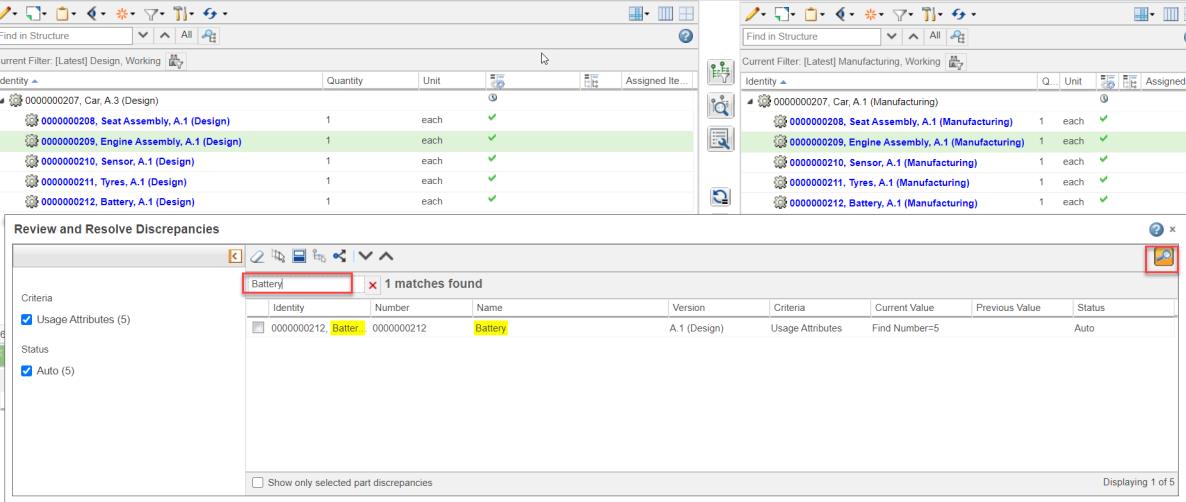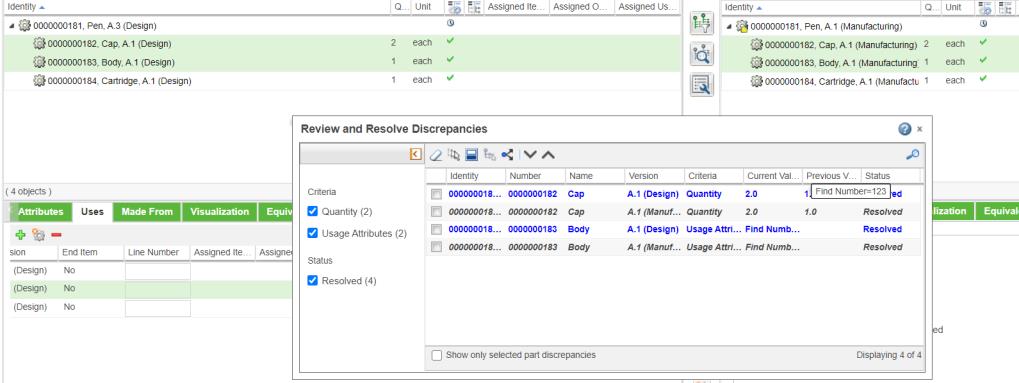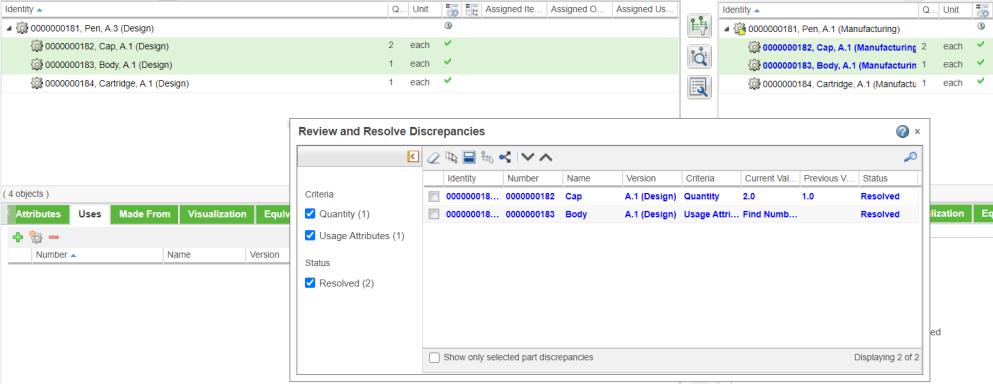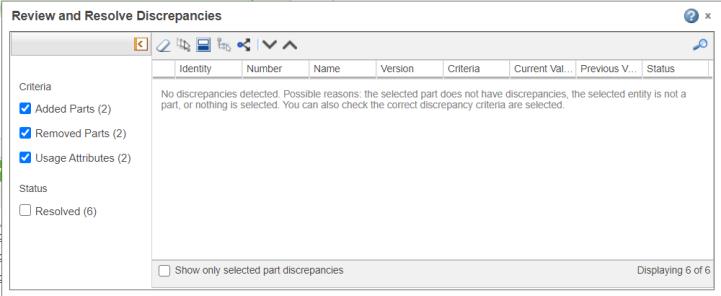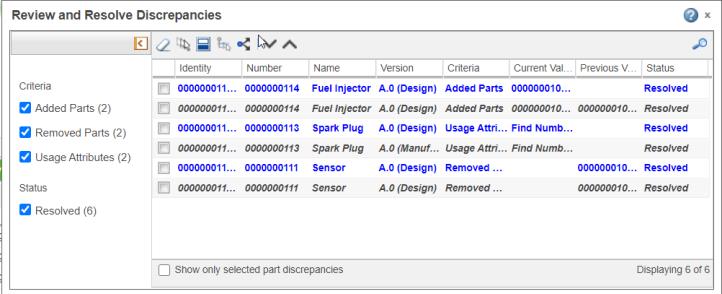About Detect and Resolve Discrepancies in BOM Transformer
When changes are made in the upstream structure of a product, it is important for the manufacturing team to be made aware of such changes so that all the changes can be synchronized in the downstream structure. These changes can be detected and resolved in a simplified manner by using the

Detect Discrepancies and

Review and Resolve Discrepancies actions in the middle pane toolbar. Here, the term discrepancies are used to indicate the differences between previous and new version of engineering bill of materials.
| In addition to the  Detect Discrepancies action, you can also use the  Reconciliation Assistance action in the middle pane toolbar to detect and resolve discrepancies. PTC recommends the use of  Detect Discrepancies to detect and resolve discrepancies. |
Detecting and Resolving Discrepancies in BOM Transformer
To detect and resolve discrepancies in tree structures, perform the following steps:
1. In the upstream tree structure, select the parts or assemblies for which you want to detect the discrepancies.
2. Click

Detect Discrepancies. The related discrepancies are highlighted in the upstream and downstream tree structures, and the
Review and Resolve Discrepancies dialog box opens. It displays the discrepancies for the highlighted parts. Review the discrepant parts listed in the table and resolve the discrepancies as needed.
| • The Review and Resolve Discrepancies dialog box includes the following status for each change: ◦ Auto—The changes in the upstream structure can be propagated to the downstream structure using the  action. ◦ Manual—The changes in the upstream structure cannot be propagated using the default logic. ◦ Interactive—The changes in the upstream structure can be propagated by using the default logic and with user interaction. Use the  action to resolve discrepancies with status as Interactive. ◦ Resolved—The changes in the upstream structure are already resolved in the downstream structure. |
3. Optionally, click

Review and Resolve Discrepancies to open the
Review and Resolve Discrepancies dialog box.
| Use the  Detect Discrepancies action before using the  Review and Resolve Discrepancies action. When you select a part and click  Review and Resolve Discrepancies, the Review and Resolve Discrepancies dialog box lists discrepancies for the selected part only if discrepancies are detected beforehand. |
4. Use the options under the
Criteria and
Status sections in the left pane to filter any specific discrepancies that you would like to review and resolve. To know more about the
Criteria and
Status sections, see
Propagating Upstream Changes.
5. Select the check boxes for the discrepancies that you want to review, resolve or both.
| You can use the Clear all, Select all, Invert selection, or Select in downstream structure actions in the Review and Resolve Discrepancies dialog box to review discrepancies. |
6. Click

to propagate changes. The changes are prorogated to the downstream side.
| A discrepant part in the upstream view can have multiple equivalent parts in the downstream view. For such discrepant parts, the  action propagates the upstream changes displayed in the Review and Resolve Discrepancies dialog box to all the equivalent parts downstream. |
You can resolve multiple discrepancies at a time. For every resolved discrepancy, two entries are created in the Review and Resolve Discrepancies dialog box.
When a discrepancy is resolved, for every resolved discrepancy, two entries of the discrepancy are created in the Review and Resolve Discrepancies dialog box. You can view those entries when you select the Resolved check box. The entry that are in italics represent the resulting downstream change. The highlighted entry in blue represents the detected upstream change that is resolved.
The entry that is in italics represents the resulting downstream change. The highlighted entry represents the detected upstream change that is resolved. If you select any of the two entries and click

Select in downstream structure action, the resolved part in downstream structure will be highlighted.
| In case of discrepancy of criteria Added Parts, the resolved part in downstream structure is highlighted only if you select the resolved discrepancy that is highlighted in the Review and Resolve Discrepancies dialog box and initiate the  Select in downstream structure action. |
The following actions are available in the Review and Resolve Discrepancies toolbar:
Icon | Action | Description |
| Clear all | Clears the selected entries. |
| Select all | Selects all the entries listed in the table. |
| Invert selection | Inverses the current selection. Clears current selection and selects the entries that are not selected |
| Select in downstream structure | |
| Propagate changes to downstream | Propagates the changes selected in the downstream tree structure. |
| Next Discrepant Part Previous Discrepant Part | Traverse up or down through the upstream structure to identify the next discrepant part. |
• It is possible sometimes that no discrepancies are listed in the Review and Resolve Discrepancies dialog box.
Here are some possible reasons for no discrepancy being detected, and suggested resolution that you can apply:
Possible Reason | Suggested Resolution |
No discrepancies detected in a selected part. | • This may happen when you execute  Review and Resolve Discrepancies before initiating the  Detect Discrepancies action. The Review and Resolve Discrepancies dialog box does not list discrepancies unless they are detected beforehand. Consider using the  Detect Discrepancies action before initiating the Review and Resolve Discrepancies action. • If you have detected the discrepancies, select a discrepant part from upstream tree structure. Alternatively, you can use  or  actions in the Review and Resolve Discrepancies dialog box to move to the next or previous discrepant part in the upstream structure. |
Selected entity is not a part. | Select a valid entity in the tree structure. |
Incorrect discrepancy criteria selected in the Review and Resolve Discrepancies dialog box. | Use the options provided in the Criteria and Status sections in the Review and Resolve Discrepancies dialog box. |
Key Points
The following considerations apply when using the

Detect Discrepancies and

Review and Resolve Discrepancies actions:
• If the selected part does not have any discrepancy, and you initiate the

Detect Discrepancies action, a message appears indicating that no upstream changes were detected.
• The

Detect Discrepancies and

Review and Resolve Discrepancies actions are enabled or available for use only when parts are selected in upstream structure. An exception to this behavior is when parts are opened in BOM Transformer from the change notice or change task information page. When you open parts from change notice or change task information page in BOM Transformer, you can use the actions without any selection.
• The implementation of the

Detect Discrepancies and

Review and Resolve Discrepancies actions depends on the values set in the
Reconciliation Assistance Criteria user level preference. When you click

Detect Discrepancies, only those parts with discrepancies that satisfy the criteria set in the
Reconciliation Assistance Criteria preference are highlighted. When set to
Out of Date, the default, the system detects all types of discrepancies.
The values specified in preference appear prepopulated in the Search for Upstream Changes section of the Propagate Upstream Changes dialog box.
• To identify or track discrepancies in a sub-assembly, select the sub-assembly and click

Detect Discrepancies. The discrepant parts in the subassembly are highlighted in the part structure. For example, an engine sub-assembly. You can detect discrepancies for multiple subassemblies at a time by selecting multiple subassemblies and initiating the

Detect Discrepancies action.
• The information in the
Downstream Context column is useful when you initiate the

Detect Discrepancies action on an out of date part in the upstream view that has equivalent parts in multiple contexts. You can resolve the discrepancies, present in these multiple contexts.
| By default, the Downstream Context column in the Review and Resolve Discrepancies dialog box is not selected. |
.
• A discrepant part upstream can have multiple equivalent parts downstream. For such discrepant parts, the

action propagates the upstream changes displayed in the
Review and Resolve Discrepancies dialog box to all the equivalent parts downstream.
• The highlight in the Review and Resolve Discrepancies dialog box disappears when you select the Show only selected part discrepancies checkbox.
• Out of the box, the following columns are available in the Review and Resolve Discrepancies dialog box: Identity, Number, Name, Version, Criteria, Current Value, Previous Value, Status, and Downstream Context. You can click the arrow in the Review and Resolve Discrepancies dialog box to select the columns as shown in the following image.
• Use

in the
Review and Resolve Discrepancies dialog box to search for discrepancies associated with a particular part. After you click

, you must type the name of the part with which the discrepancy is associated.
• Select a discrepant part from the upstream tree structure to view the corresponding discrepancy in the Review and Resolve Discrepancies dialog box. The selection of parts in the downstream tree structure does not impact the results in the Review and Resolve Discrepancies dialog box.
• When you select the Resolved check box in the Status section, a list of resolved discrepancies appears. The entry for the resulting downstream change, that is indicated by italics, disappears when you select a different part in the upstream tree structure and then again select the previously-selected part for which discrepancies were displayed. For example, initially when the Cap and Body parts are selected, the Review and Resolve Discrepancies dialog box displays discrepancies related with that part.
If you select a non-discrepant part, for example, Cartridge, only detected upstream changes are displayed.
If you select the Cap and Body parts again, the resulting downstream changes disappear.
• Select a discrepant part from the upstream tree structure to view the corresponding discrepancy in the Review and Resolve Discrepancies dialog box.
• The selection of parts in downstream tree structure does not impact the results on the Review and Resolve Discrepancies dialog box.
• The Resolved check box in the Status section of the Review and Resolve Discrepancies dialog box is not selected by default when you resolve a discrepancy in the Review and Resolve Discrepancies dialog box. If you want to view the resolved discrepancies, you need to select the Resolvedcheck box. For example, in the following image, the Resolved check box is cleared:
When the Resolved check box is selected:
• Select the Resolved check box in the Status section to view a list of resolved discrepancies.
The entry for resulting downstream change, that is indicated by italics disappears when you select a different part in upstream tree structure and then come back to the previously selected part for which discrepancy were displayed. For example, initially when the Cap and Body parts are selected, the Review and Resolve Discrepancies dialog box displays discrepancies related with that part.
If you select a non-discrepant part, for example, Cartridge, no discrepancies are displayed.
If you select the Cap and Body parts again, the resulting downstream changes disappear.
• It may happen that discrepancies, for parts that are not present in the BOM Transformer, are displayed in the Update to Current Equivalent Objects dialog box. This happens, because of the filter criteria applied on the structures in the BOM Transformer.
• Consider that you removed some parts from the tree structure and initiated the

Detect Discrepancies action. The parent parts of the parts that were removed from the structure before initiating the

Detect Discrepancies action are highlighted in the upstream tree structure. The parts that were removed appear as discrepancies in the
Review and Resolve Discrepancies dialog box. Also, the removed parts are highlighted in the downstream tree structure. You can use the
Removed Parts check box to view or hide these discrepancies.
• You can move the Review and Resolve Discrepancies dialog box within the BOM Transformer window.
• As a best practise, you must resolve as many discrepancies as possible, that appear in the Review and Resolve Discrepancies dialog box.
• A part in upstream can have multiple equivalent parts in downstream. The discrepancies are resolved only for the parts on which the

Detect Discrepancies is initiated.
Related Topics
 Detect Discrepancies and
Detect Discrepancies and  Review and Resolve Discrepancies actions in the middle pane toolbar. Here, the term discrepancies are used to indicate the differences between previous and new version of engineering bill of materials.
Review and Resolve Discrepancies actions in the middle pane toolbar. Here, the term discrepancies are used to indicate the differences between previous and new version of engineering bill of materials. Detect Discrepancies and
Detect Discrepancies and  Review and Resolve Discrepancies actions in the middle pane toolbar. Here, the term discrepancies are used to indicate the differences between previous and new version of engineering bill of materials.
Review and Resolve Discrepancies actions in the middle pane toolbar. Here, the term discrepancies are used to indicate the differences between previous and new version of engineering bill of materials. Reconciliation Assistance action in the middle pane toolbar to detect and resolve discrepancies.
Reconciliation Assistance action in the middle pane toolbar to detect and resolve discrepancies.
 action.
action.



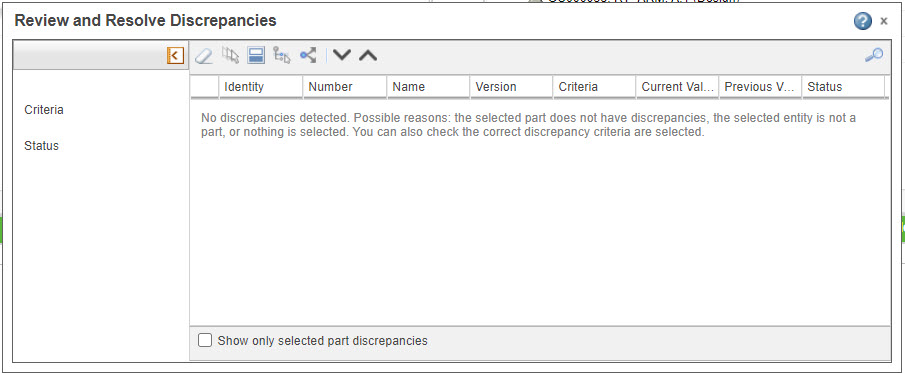
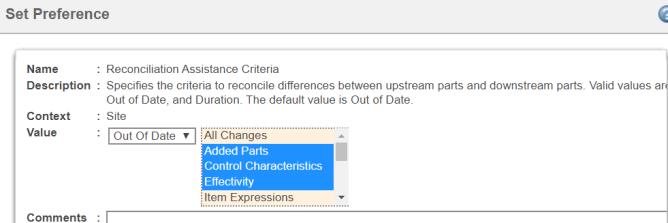

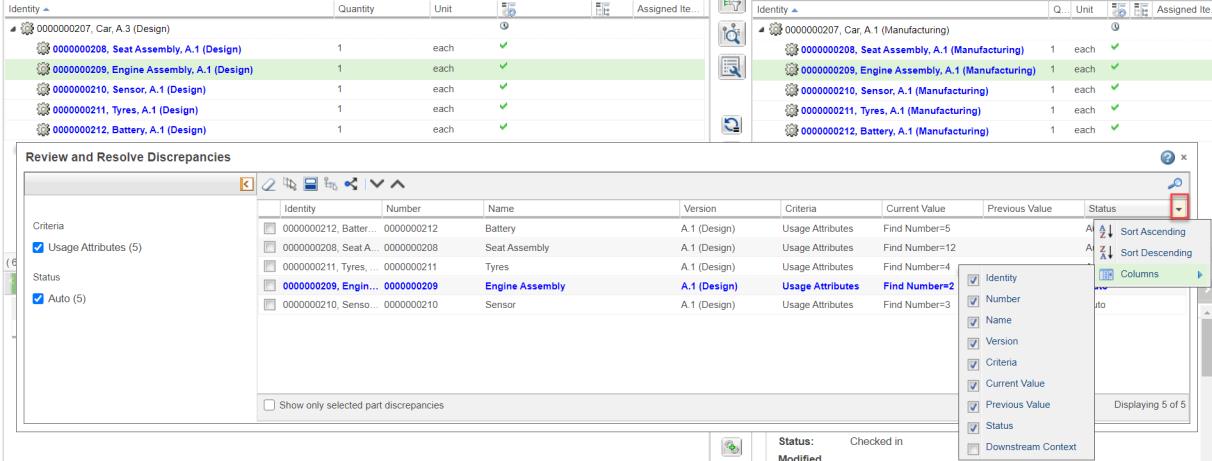
 in the
in the 